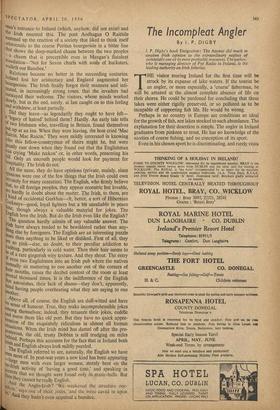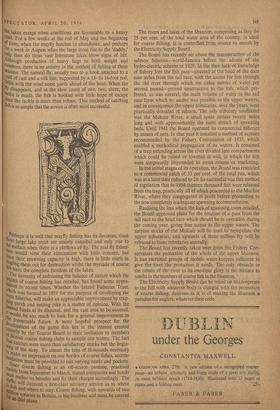The Incompleat Angler
By J. P. DIGBY .1. P. Digby's book Emigration : The Answer did much to awaken Irish opinion to the extraordinary neglect of potentially one of its most profitable resources. T he author, who is managing director of Pye Radio in Ireland. is the leading authority on Irish fisheries.
THE visitor touring Ireland for the first time will be struck by its expanse of lake waters. If the tourist be an angler, or more especially, a 'coarse' fisherman, he will be amazed at the almost complete absence of life on their shores. He could be pardoned for concluding that these lakes were either rigidly preserved, or so polluted as to be incapable of supporting fish life. He would be wrong.
Perhaps in no country in Europe are conditions so ideal for the growth of fish, nor lakes stocked to such abundance. The explanation for their desertion is simple. The angler in Ireland graduates from pinkeen to trout. He has no knowledge of the niceties of coarse fishing, and no conception of its sport.
Even in his chosen sport he is discriminating, and rarely visits the lakes except when conditions are favourable to a heavy ereel. For a few weeks at the end of May and the beginning °f June, when the mayfly hatches in abundance, and perhaps fora week in August when the large trout rise to the 'daddy,' °Ply then do these vast limestone lakes show signs of life. Although productive of heavy bags in both weight and numbers, there is, no artistry in the method of fishing at these seasons. The natural fly, usually two to a hook attached to a 4!*(1 of cast and a silk line, supported by a 15- to 16-foot rod, drifts with the wind some yards ahead of the boat. When the flY disappears, and at the slow count of one, two, three, the strike is made, the fish is hooked with little hope of escape since the tackle is more than robust. This method of catching fish is so simple that the novice is often most successful.
, Perhaps it is well that mayfly fishing has its devotees, since these large lake trout are mainly cannibal and only rise to the surface when there is a plethora of fly. The real fly fisher- 4" would view their elimination with little concern, but 'nee their spawning capacity is high, there is little merit in ngling them out for destruction whilst the myriads of coarse. gsrl have the complete freedom of the lakes. The necessity of redressing the balance of nature which the tegleet of coarse fishing has entailed, has found some appre- Tfion in recent times. Whether the Inland Fisheries Trust, ""hick was formed in 1951 for the purpose of developing the :ront fisheries, will make an appreciable. improvement by trap- VnIg perch and netting pike is a matter of opinion. With the ahed funds at its disposal, and the vast area to be covered, it Would be too much to look for a general improvement in the foreseeable future. A more hopeful prospect for the :veloPment of the game fish lies in the interest created 'fcently by the Tourist Board in their invitation to members th coarse fishing clubs to sample our waters. The fact Iiiat catches were more than satisfactory marks but the begin- tng of the story. To attract the tens of thousands necessary o ,„ nlake an impression on our hordes of coarse fishes, accom- modation must be provided to suit varying needs and pockets. :,inee coarse fishing is an off-season pastime, practised from September to March, transit companies and hotels must r „. realise its benefits and fix their charges accordingly. The to',11,1e will demand a first-class advisory service as to where and where to stay. Coarse fishing, with upwards of two foQlton vtaries in Britain, is big business and must be catered " (In that plane. The rivers and lakes of the Shannon, comprising as they do 25 per cent. of the total water area of the country, is ideal for coarse fishing. It is controlled from source to mouth by the Electricity Supply Board.
The Board has recently set about the reconstruction of the salmon fisheries—world-famous before the advent of the hydro-electric scheme in 1929. In the then lack of knowledge of fishery lore the fish pass—situated at the head of the darn nine miles from the tail race, with the ascent for fish through the old river through which ten cubic metres of water per second passed—proved unattractive to the fish, which pre- ferred, as was natural, the main volume of water in the tail race from which no ascent was possible to the upper waters; and in consequence the upper tributaries, over the years, were practically denuded of salmon, The only tributary unaffected was the Mulcair River, a small spate stream twenty miles long and with approximately the same stretch of spawning beds. Until 1941 the Board operated its commercial fisheries by means of nets. In that year it installed a method of capture recommended by the Fishery Commission of 1935, which enabled a methodical propagation of its waters. It consisted of a trap extending across the river divided into compartments which could be raised or lowered at will, in which the fish were temporarily impounded to await release or marketing.
In the initial stages of its operation, the Board was restricted to a commercial catch of 33 per cent. of the total run, which was at a later date reduced to 28. So successful was this method of regulation that in 1954 thirteen thousand fish were released from the trap, practically all of which proceeded to the Muclair River, where they congregated in pools before proceeding to the now completely inadequate spawning accommodation. Realising the loss which the lack of spawning room entailed, the Board approved plans for the erection of a pass from the tail race to the head race which should be in operation during the coming year, giving free access to the upper waters. The surplus stocks of the Mulcair will be used to repopulate the upper tributaries, and upwards of three million fry will be released to those tributaries annually.
The Board has recently taken over from the Fishery Con- servators the protection of the whole of the upper Shannon. It has recruited groups of mobile water-keepers sufficient to give the river the protection it needs. The only obstacle to the return of the river to its one-time glory is the menace to molts in the numbers of coarse fish in the Shannon.
The Electricity Supply Board can be relied on to co-operate to the full with whatever body is charged with the promotion of coarse fishing, desirous as it is of making the Shannon a paradise for anglers, whatever their code.



















































 Previous page
Previous page